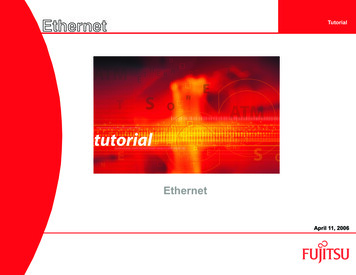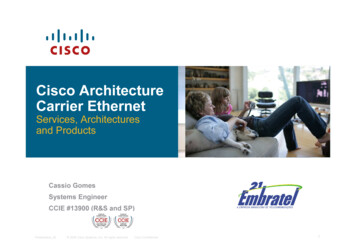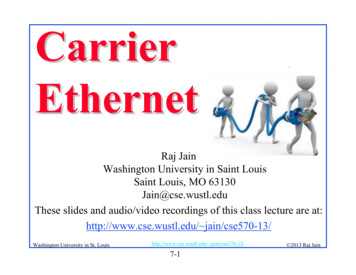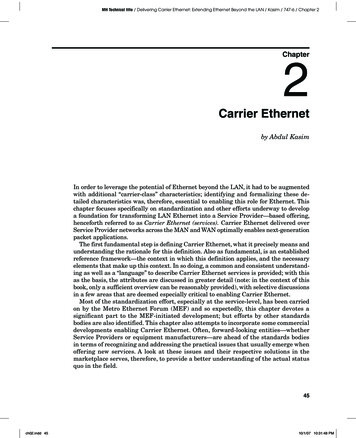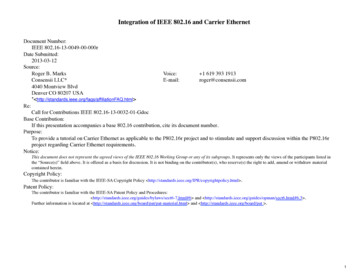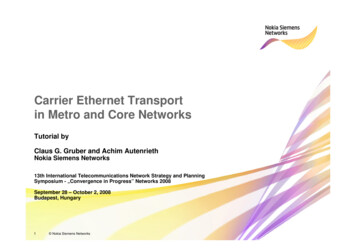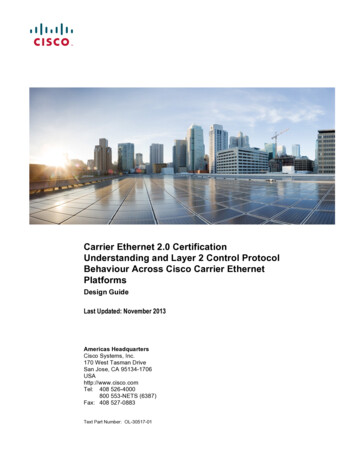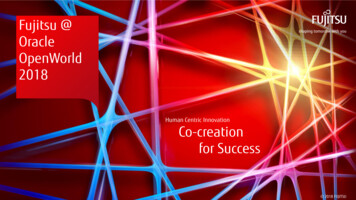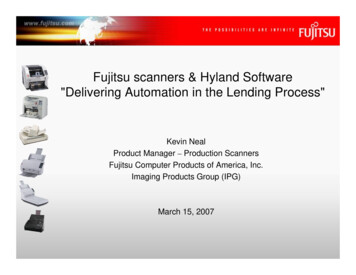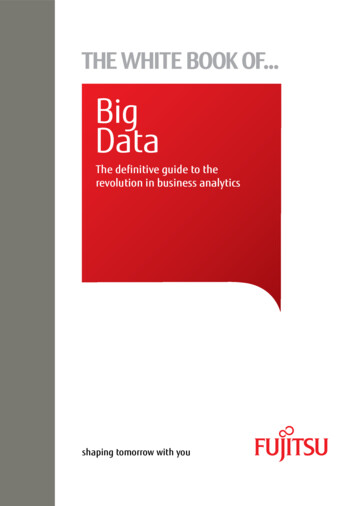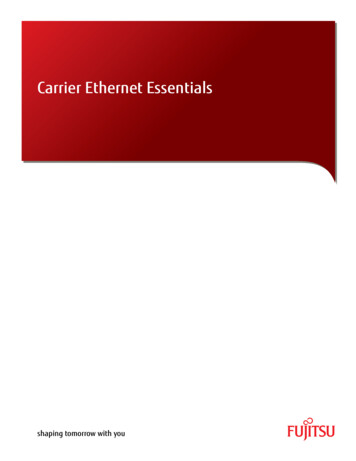
Transcription
Carrier Ethernet Essentialsshaping tomorrow with you
Carrier Ethernet EssentialsMany technologies are used to deliver metro and wide-area services.Layer 1 TDM technologies used to deliver private line services includeT1 and T3 copper circuits, and SONET-based optical circuits. Layer 2technologies used to deliver data services over the Layer 1 TDMtechnologies include Frame Relay, ATM and PPP.Carrier Ethernet addresses the limitations of legacy technology byproviding flexible bandwidth scalability. Once an Ethernet service isdeployed, bandwidth can be added simply through remote provisioningup to the Ethernet port speed. This enables the service provider tosell, or enterprise to deploy, the amount of bandwidth subscribersactually need, rather than forcing them to buy a particular amountof bandwidth dictated by the legacy technology. In addition, it is notnecessary to send a service technician to the customer premises, whichgenerates additional OpEx savings when compared to legacy services.These legacy technologies provide inflexible bandwidth scalabilitybecause the bandwidth is dictated by the technology. When a serviceprovider or enterprise needs to add bandwidth, they either bondmultiple circuits together or upgrade their network and equipment tosupport a new technology. This results in non-linear bandwidth thatmay not be at the bandwidth increment that the subscriber needs or,more importantly, can afford.With Carrier Ethernet, subscribers can now use the same, wellunderstood Ethernet technology for their LAN, MAN and WANconnections. This reduces CapEx for the equipment to connect to theservice. It also simplifies operations and training.OC-192SONETOC-48Carrier Ethernet provides flexiblebandwidth increments and the ability toadd new services using one technology.OC-12OC-3ATMCarrier Ethernet versus EthernetT-3T-1When most think of Ethernet, they think of Ethernet as a LANtechnology. Three fundamental aspects differentiate Ethernet LANsfrom Carrier Ethernet:Frame Relay1.5 Mbps45 Mbps 155 Mbps2.4 Gbps Each user connects to a dedicated Ethernet port on the LAN The LAN serves one organization The LAN is inside the building10 GbpsFigure 1: Non-Linear Bandwidth Increments of Legacy TechnologiesBonding circuits together results in additional ports on the networkequipment (CapEx). Bonding circuits also increases operationalcomplexity (OpEx), since each circuit is managed individually andthe data service is managed over the bonded circuits. Finally, newOAM tools are required as technologies are changed to support higherbandwidths.With legacy technologies, addingbandwidth often requires a technologychange, causing service disruption andlonger time to revenue.FUJITSU NETWORK COMMUNICATIONS INC.2801 Telecom Parkway, Richardson, Texas 75082-3515Telephone: (972) 690-6000(800) 777-FAST (U.S.)us.fujitsu.com/telecomLANFigure 2: Ethernet LANEthernet is prefixed with the word “Carrier” to indicate its usageand additional capabilities. These additional capabilities enableend-users to build MANs and WANs, and service providers to buildnetwork infrastructure or deliver Ethernet-based MAN or WANtelecommunications services.For your convenience, a list of acronyms can be found at the end of this document.1
Carrier Ethernet EssentialsCarrier Ethernet augments the original set of Ethernet LANtechnologies with support for the new capabilities required to deliverservices. Three fundamental aspects differentiate Carrier Ethernetnetworks from Ethernet LANs: An entire organization connects to a Carrier Ethernet “port” at agiven subscriber location The Carrier Ethernet network serves many organizations The Carrier Ethernet network is outside the building across awide areaCarrier Ethernet EcosystemThe MEF defines Carrier Ethernet based on five attributes asillustrated in Figure 4. Carrier Ethernet uses many of the Ethernet LANtechnologies but required further augmentation in order to function asa service delivery technology for MANs and WANs. The five MEF CarrierEthernet attributes focus on these service delivery aspects for Ethernetusage outside of the LAN.StandardizedServicesIP Network& Figure 4: MEF's Five Attributes of Carrier EthernetFigure 3: Carrier Ethernet NetworkCarrier Ethernet TaxonomyCarrier Ethernet is used for different purposes in the network.The Carrier Ethernet taxonomy, shown in Figure 5, illustrates theinterrelationships among its different roles in the network.ApplicationSite-to-SiteL2 VPNPrivateLineEthernetConnectivityService tAccessVideoCloudService3G/4GMBHE-Line, E-LAN, E-Tree, rnet over DryCopperEthernetoverμWaveFigure 5: Carrier Ethernet TaxonomyFUJITSU NETWORK COMMUNICATIONS INC.2801 Telecom Parkway, Richardson, Texas 75082-3515Telephone: (972) 690-6000(800) 777-FAST (U.S.)us.fujitsu.com/telecom2
Carrier Ethernet EssentialsCarrier Ethernet InfrastructureCarrier Ethernet is an infrastructure technology that can beimplemented over many different types of Layer 1 transport networktechnologies. Figure 6 provides more detail about the transporttechnologies used to deliver the Ethernet services listed in Figure 5.Ethernet overLayer 1 TransportApplicationSite-to-site Layer 2 VPNsHigh bandwidth and more flexiblereplacement for the popular Frame RelayLayer 2 VPNsEPLSimilar characteristics to a Layer 1private line but delivered using EthernetinterfacesWholesale EthernetaccessFirst/last mile Ethernet services enablingservice providers to reach out-of-franchisecustomer premises3G/4G cell site mobilebackhaulInterconnecting 3G/4G base stations at cellsites to their base station controllers at amobile switching centerEthernet access to IPservices Ethernet access to managed IP VPNs Ethernet dedicated Internet access Ethernet access to cloud services Ethernet backhaul of IP video fromDSLAM, GePON or CMTS aggregatorDescriptionEthernet over FiberEthernet over IEEE 802.3 EthernetLayer 1 transportEthernet overSONET/SDHEthernet encapsulated in ITU-T G.8040 GFPover SONET/SDH virtual concatenation groupsEthernet over PDHEthernet encapsulated in ITU-T G.8041 GFPover single or bonded T1, E1, T3 or E3 circuitsEthernet over MPLSEthernet with MPLS shim header used overany Layer 1 transportEthernet over OTNEthernet encapsulated in ITU-T G.709digital wrapperEthernet over WDMEthernet transported over differentwavelengths (lambdas)Ethernet over drycopper pairsEthernet encapsulated in ITU-T G.SHDSLEthernet over µWaveEthernet transported over microwavefrequency spectrumFigure 6: Ethernet over Different Layer 1 Transport TypesEthernet Connectivity Service TypeCarrier Ethernet is also a service delivery technology used to delivera variety of MEF-defined types of connectivity services, includingE-Line, E-LAN and E-Tree for retail services, and E-Access for wholesaleaccess services (discussed in the section covering Ethernet servicedefinitions). Ethernet connectivity services are delivered over variousCarrier Ethernet transport technologies, leveraging a heterogeneousset of transport network technologies.Carrier Ethernet-Enabled ApplicationsThe applications enabled by a Carrier Ethernet network infrastructureinclude Ethernet Layer 2 networking and Ethernet access to IP (Layer 3)services. Figure 7 provides more details for the Ethernet-enabledapplications listed in Figure 5.FUJITSU NETWORK COMMUNICATIONS INC.2801 Telecom Parkway, Richardson, Texas 75082-3515Telephone: (972) 690-6000(800) 777-FAST (U.S.)us.fujitsu.com/telecomDescriptionFigure 7: Ethernet-Enabled ApplicationsEthernet or MPLS for Carrier Ethernet?There has been a misconception that MPLS is required to implement aCarrier Ethernet network. This is partly because when the market was inits infancy, service providers used enterprise-class Ethernet switches intheir first Carrier Ethernet deployments. Hence, the “switched Ethernetservices” delivered over these networks gave Carrier Ethernet a badreputation. While these services could provide higher bandwidth andmore flexible connectivity options than their legacy counterparts, theylacked any meaningful performance that could be specified in a highquality SLA like those that customers received for their legacy services.Just as MPLS was used to improve the performance of “best-effort” IPnetworks, it was again utilized to improve the performance of theseearly Carrier Ethernet network deployments. MPLS brought a number ofuseful capabilities such as fast-reroute to significantly reduce networksegment protection and restoration times, and VPLS to increasethe scalability required in metro networks with large numbers ofsubscribers.Carrier Ethernet technologies and standards have come a long waysince those early days and can now provide the performance andscalability that were once only available through the use of MPLStechnologies.3
Carrier Ethernet EssentialsEthernet technologies have come along way and can now provide thesame capabilities that were once onlyavailable through MPLS.What Problem are You Trying to Solve?Whether to use an Ethernet-centric or MPLS-centric technologyimplementation of Carrier Ethernet, you need to understand theproblem you are trying to solve. Are you aggregating triple-play IP services in a metro network? Are you delivering metro or long-haul Ethernet services? Do you need to transport legacy services, such as ATM or FrameRelay, alongside your Ethernet and IP services over a convergednetwork? Are you backhauling 2G (TDM), 3G (ATM) and 4G Ethernet servicesfrom cell sites, or only 3G (Ethernet) and 4G?F or delivering Ethernet services, aggregating IP services from youraccess/aggregation networks or backhauling 3G or 4G IP wireless dataservices from Ethernet-attached devices, an Ethernet-centric approachshould result in lower OpEx than an MPLS-centric approach.If the traffic is all Ethernet-based, anEthernet-centric approach to CarrierEthernet makes more sense.A transport/transmissions organization deploys SONET/SDH, WDMor OTN Layer 1-centric technologies, which are light in protocols,and the OAM tools support circuit-based (P2P connection-oriented)applications. Conversely, a data organization deploys IP and MPLScentric technologies, which use many protocols, and the OAM toolssupport any-to-any connectionless applications. They may implementsome traffic engineering to steer traffic down certain paths forcertain applications but the latter technologies are fundamentallyconnectionless.What are the Business Case and ROI Objectives?It is easy to have an academic discussion to converge all traffic overa common network infrastructure. However, there must be businessand financial justification to, for example, converge TDM and legacyservices, such as ATM and Frame Relay, over a common Carrier Ethernetnetwork. If the TDM or legacy service growth rate is limited or flat, isthere a business case to migrate these services to the Carrier Ethernetnetwork or simply keep them on their current network?Most services are moving to IP so it is often possible to restrict legacyservices to the access network and provide a gateway to terminatelegacy protocols, extract the IP payloads and transport them over aCarrier Ethernet network, for example, by using a VoIP gateway toconvert legacy PBX voice traffic to VoIP.As you evaluate these business considerations, it becomes a muchsimpler choice to determine whether to take an Ethernet-centric orMPLS-centric approach with your Carrier Ethernet implementation.Carrier Ethernet Building BlocksFor transporting or backhauling multiservice traffic over a convergednetwork, such as a combination of Ethernet, TDM and ATM, an MPLScentric approach makes more sense given the inherent strengthsof MPLS in supporting multiservice traffic types. While Ethernetcentric technologies such as circuit emulation exist for transportingmultiservice traffic, they have achieved limited deployments given thelonger heritage of multiservice support in MPLS.Finally, you need to determine if there is a business case to convergeEthernet and legacy traffic over a common network infrastructure.If your legacy TDM and ATM services have limited to no growth, is itworth the time and expense to converge them over the same networkwith your high-growth Ethernet and IP services? The legacy networkmay already be amortized and operating at optimal efficiency, so thebest approach may be to leave it in place until the legacy servicessignificantly decline or are replaced by Ethernet.Which Organization is Deploying Carrier Ethernet?When assessing the implementation choices for Carrier Ethernet,it is essential to consider the organization’s skill set and OAM toolsavailable to deploy and support a given technology.FUJITSU NETWORK COMMUNICATIONS INC.2801 Telecom Parkway, Richardson, Texas 75082-3515Telephone: (972) 690-6000(800) 777-FAST (U.S.)us.fujitsu.com/telecomThis section describes the building blocks which are used to create anEthernet Service.Ethernet Service DemarcationEthernet service demarcation consists of two fundamental interfacetypes, namely the Ethernet UNI and Ethernet ENNI. UNIs and ENNIsprovide delineation between the responsibilities of buyers and sellersof services. Service demarcation is important for service assurance andtroubleshooting. In the event of a service outage, service demarcationdetermines who is responsible for troubleshooting the service up to theUNI or ENNI to which they attach.If you need to transport Ethernet andlegacy services over a converged network,an MPLS-centric approach to CarrierEthernet makes more sense.4
Carrier Ethernet EssentialsEthernet UNIThe Ethernet UNI is the physical Ethernet interface to which the enduser subscriber attaches their network to the service. Subscriber sitesalways attach to the service provider’s network using a UNI. Refer toFigure 8.An Operator is used when the Service Provider cannot reach all enduser Subscriber locations on their network facilities. These Subscriberlocations are “off-net” or “out-of-franchise”. In this case, the ServiceProvider must rely on another Operator’s network to reach these off-netSubscriber locations.Ethernet Virtual ConnectivitySubscriber SiteLANServiceProvider’sNetworkUNIFigure 8: UNI Demarcation Between Service Provider and SubscriberThe UNI also provides the demarcation between the responsibilities ofthe subscriber and service provider. In the event of a service outage,the service provider is responsible for troubleshooting the service fromtheir network up to the UNI and the subscriber is responsible for theirLAN up to the UNI.Ethernet ENNIThe Ethernet ENNI is the physical Ethernet interface that providesservice demarcation between two service providers’ networks. Eachservice provider is responsible for their respective side of the servicedemarcation, up to the ENNI interconnection point. Refer to Figure 9.WholesaleAccessProviderENNIThe MEF has defined two types of Ethernet virtual connectivityconstructs, namely, the EVC and the OVC. EVCs and OVCs enable oneto better visualize a service rather than show the complete physicalconnectivity between the UNI or ENNI endpoints.Ethernet Virtual ConnectionsAn EVC is the logical association between two or more UNIs. EVCs areuseful for describing the virtual connectivity of a service between UNIendpoints. The MEF has defined three types of EVCs, namely MP2MP,P2P and RMP). An EVC is a retail Ethernet service construct, meaningthat it is used to describe the logical connectivity of a service deliveredbetween a service provider and an end user subscriber.The MP2MP EVC is most similar to Ethernet’s usage in a LAN, whichis technically referred to as CLE. An MP2MP EVC provides a broadcastdomain such that all Ethernet service frames associated with theEVC are visible to and accessible by all UNI members of the EVC. AnMP2MP EVC provides LAN-like connectivity but over greater distances,interconnecting typically three or more remote locations. Refer toFigure ure 9: ENNI Service Demarcation between ProvidersThe MEF defines two types of service providers who interconnect atan ENNI. One is called an Operator and the other is called a ServiceProvider. Per the MEF definitions, the Service Provider sells Ethernetservices to end user buyers whose sites are connected to the networkvia an Ethernet UNI. The Operator sells Ethernet services to the ServiceProvider whose networks are interconnected via an Ethernet ENNI.Figure 10: Multipoint-to-Multipoint EVCThe Retail Service Provider in Figure 9 is the MEF’s “Service Provider”who would have the business relationship with the end user Subscriber.The Wholesale Access Provider is the MEF’s Operator who would have abusiness relationship the Retail Service Provider and not the end userSubscriber.FUJITSU NETWORK COMMUNICATIONS INC.2801 Telecom Parkway, Richardson, Texas 75082-3515Telephone: (972) 690-6000(800) 777-FAST (U.S.)us.fujitsu.com/telecom5
Carrier Ethernet EssentialsP2P EVCs provide connectivity similar to other P2P MAN/WANconnectivity technologies such as T1s/E1s or Frame Relay. The P2P EVCprovides connectivity between two UNIs where all frames sent to theEVC from one UNI are received by the other UNI. Refer to Figure 11.The RMP EVC is very similar to a hub-and-spoke topology where a hubUNI has a set of service multiplexed P2P EVCs. However, the latter caseconsists of N-1 EVCs (where N is the number of UNIs) where the RMPimplementation requires only one EVC. Refer to Figure 13.HubUNIUNIUNIP2P EVCSpokeUNISpokeUNIRootUNI3 P2PEVCSpokeUNILeafUNILeafUNI1 RMPEVCLeafUNIFigure 11: Point-to-Point EVCRMP EVCs are a special case of a MP2MP EVC where one of the UNIs isdesignated as the Root UNI and the remaining UNIs are designatedas Leaf UNIs. A Root UNI has full connectivity to all other UNIs, whileLeaf UNIs only have connectivity to the Root UNI. The RMP EVC isused for aggregation applications, where the Leaf UNIs only need tocommunicate to the Root UNI and not other Leaf UNIs. Refer to Figure12. The RMP EVC is also used for broadcast applications. For example,in a broadcast video application, the Root UNI could broadcast TVchannels to all Leaf UNIs and the Leaf UNIs send channel-changinginformation from each subscriber’s set-top box back to the Root UNI.Another application is Internet access aggregation, where the RootUNI has a connection to the Internet and the Leaf UNIs connect to theInternet via the Root UNI’s Internet e 13: RMP and P2P EVC Hub and Spoke ComparisonSince service providers typically charge for each EVC, the subscribershould be able to purchase a lower-cost service using an RMP EVCwhen compared to a P2P EVC implementation for a hub-and-spokeapplication. An additional benefit of an RMP EVC is that it canbroadcast traffic from the Root UNI to all Leaf UNIs. A hub-and-spokeimplementation using P2P EVCs requires an external device, such as arouter or Ethernet switch, to replicate the traffic sent over each EVC.Operator Virtual ConnectionsAn OVC is the logical association between a UNI and ENNI or betweentwo ENNIs. OVCs are useful for describing the virtual connectivity of aservice between UNI-ENNI or ENNI-ENNI endpoints. An OVC is also asegment of an EVC whereby two or more OVCs can be concatenatedto create an EVC. An EVC that traverses multiple provider networksconsists of a sequence of OVCs.An OVC is a wholesale Ethernet service construct, meaning that it isused to describe the logical connectivity of a service delivered betweenproviders. The MEF has currently defined two types of OVCs, namelyMP2MP and P2P. Today, P2P OVCs are more popular, owing to theirsimplicity over MP2MP OVC implementations.ENNIMP2MPOVCFigure 12: Rooted Multipoint EVCUNIUNIUNIFigure 14: Multipoint-to-Multipoint OVCMP2MP OVC
Carrier Ethernet network, for example, by using a VoIP gateway to convert legacy PBX voice traffic to VoIP. As you evaluate these business considerations, it becomes a much simpler choice to determine whether to take an Ethernet-centric or MPLS-centric approach with your Carrier Ethernet implementation.File Size: 2MB
